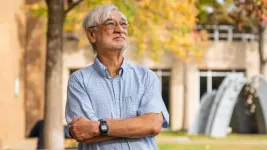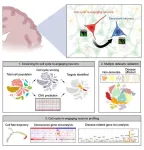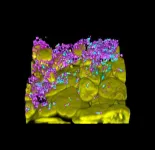(Press-News.org) As computer programming becomes an increasingly valued skill in the workforce, there is a greater need to understand how people learn to code most effectively.
Statistics show that up to 50% of students who enroll in introductory programming courses in the United States eventually drop out, suggesting a mismatch between how coding is learned and the way it’s taught. A new study from the University of Washington, published March 5 in Scientific Reports, examines that issue.
The researchers recorded electrophysiological brain responses of varyingly skilled programmers as they read lines of code written in Python, a programming language. The brain’s response to viewing errors in both the syntax (form) and semantics (meaning) of code appeared identical to those that occur when fluent readers process sentences on a word-by-word basis, supporting a resemblance between how people learn computer and natural languages.
UW News spoke with co-authors Chantel Prat, a UW professor of psychology, and Chu-Hsuan (Iris) Kuo, a recent UW doctoral graduate of psychology, about their research, the future of teaching computer programming and more.
Why is it important to understand how learning computer programming works in the brain?
Iris Kuo: The idea of programming as literacy is something we wanted to focus on. We wanted to approach learning to program from a language learning perspective, specifically from a second language learning perspective. We’ve learned a lot about what makes a second language easy or difficult to learn and why some people are good at it and some people struggle. Now we’re applying that lens to programming. If we can approach this topic from a different perspective, maybe we can address some myths or bring up new questions.
Chantel Prat: The idea of programming as the literacy of the future is important. There’s an increasing need and desire for programming in the workforce — as of 2016 over 20% of listed jobs required coding skills. It used to be this kind of niche skill that software engineers held, but now it’s central to all STEM fields. Coding is a potential bottleneck to employment, but Intro to Programming continues to be one of these notoriously hard classes with high dropout rates. This is also a field where gender gaps are closing more slowly than other fields.
Everyone wants to tell you what it takes to be a good programmer, but many of their ideas aren’t substantiated with science. Many of them are tied to culturally-linked ideas about who is already a good programmer. We know a lot about why and for whom learning a natural language is hard or why learning to read is hard. The question now was, can we leverage that expertise to start understanding how people with different levels of expertise understand code?
How did you conduct this research, and what were the main takeaways?
IK: There’s a lot of literature in the second-language learning community that uses the event-related potential, or ERP, where we place sensors on people’s heads and record their electrical activity to different stimulus. In this case, they were reading code. There are two distinct markers that indicate someone is processing meaning and when someone is processing form, like grammar. We wanted to use these two indicators to see if someone might react the same way while reading code.
If you’re a native speaker of a language, or if you’re really proficient, you tend to react to errors in meaning with a brain response marker called N400. You also tend to react to errors in grammar with a marker called P600. The more proficient you are in a language, the more distinct these markers are. When you’re first learning a language, you may be able to recognize something wrong with a sentence, but you may not be able to automatically process something as an error in meaning or grammar. Your brain takes time to learn these rules of grammar. Newer second-language learners tend to respond to most errors with the N400 marker, even when the error is grammatical. Over time, they learn to distinguish between something wrong with meaning and something wrong with grammar.
We wanted to see if something like that would happen with coding in people with a wide range of expertise. While all participants responded to errors in meaning and form in code, the higher their level of expertise, the stronger and more distinct their responses to the errors. This matches with what we have traditionally seen in second-language learners, where the more expertise you have in a natural language, the more sensitive you are to errors. This was the first study that realized we could have these neurological markers in coding and that people do process code incrementally.
CP: It was originally thought that N400 and P600 markers were language specific. For a very long time, they were the gold standard for understanding brain processes associated with language comprehension. When research showed you can find them in certain cases for music and math, that was a huge deal. So, these markers aren’t language-specific; they’re about making meaning and how we understand what we take in incrementally.
Our study showed that when somebody reads a line of code with a bracket instead of a parenthesis, for example, their brain reacts in the same way as when they read a sentence with the wrong verb ending. And the fact that progression of sensitivity to form and meaning follows the same pattern as second language learning with increasing expertise is what we hoped to find, but it’s still pretty exciting!
What does the future of this area of research look like, and what is the potential impact on coding education?
IK: We started with the coding language Python because it’s one of the fastest-growing programming languages and one of the simpler languages for people to learn. It was designed to be really reader friendly. But the reality is, there are hundreds of other programming languages that serve different purposes. Some programming languages are more difficult or easier to learn, just like natural languages. We’re working toward looking more extensively at the brain and seeing if our results can be replicated with other languages. I think this could impact the way we teach it.
Let’s say a language is more reliant on structure, can you teach it the same way you teach something like Python? If we want to approach it from a language learning lens, how would we adapt that to accommodate something like Java, which is maybe more difficult for some people to learn?
CP: People have been talking about the gap between the way coding is taught and the way it’s best learned since at least the 1980s. Coding education originated in an engineering culture — specifically a software engineering culture. Moving forward, there’s good reason to support the idea of coding as learning a language, like learning to speak with computers. It should be taught like a language where you have elements of learning syntax, but you also have a lot of practice and “conversation” classes where you produce code in small groups. This also creates the option of using coding courses to fulfill second language requirements. There may not be a one-size-fits-all best practice for computer programming education, but I think it’s useful to understand the way different people learn through a second-language-learning model.
This research was funded by the Office of Naval Research, Cognitive Science of Learning Program.
For more information, contact Kuo at kuoc@uw.edu and Prat at csprat@uw.edu.
END
Q&A: UW research shows neural connection between learning a second language and learning to code
2024-04-23
ELSE PRESS RELEASES FROM THIS DATE:
Keane wins 2024 Gopal K. Shenoy Excellence in Beamline Science Award
2024-04-23
Physicist Denis T. Keane is the 2024 recipient of the Gopal K. Shenoy Excellence in Beamline Science Award. He is a beamline scientist and director of the Dupont-Northwestern-Dow Collaborative Access Team (DND-CAT) at the U.S. Department of Energy’s (DOE) Advanced Photon Source (APS) at DOE’s Argonne National Laboratory. He is also a research professor in the Materials Science and Engineering Department at Northwestern University.
The annual award recognizes active beamline scientists at the APS, ...
Livestock abortion surveillance could protect livelihoods and detect emerging global pathogens
2024-04-23
A small-scale surveillance system in Tanzania for reporting livestock abortions could help protect livelihoods and provide insights on potential livestock-to-human infections.
The research, published April 16 as a Reviewed Preprint in eLife, is described by editors as an important study with convincing findings of potential interest to the fields of veterinary medicine, public health and epidemiology.
Loss of livestock through abortion is a major concern for the worldwide livestock industry, resulting in significant ...
Optimal timing maximises Paxlovid benefits for treating COVID-19
2024-04-23
Researchers have described the optimal timing for COVID-19 patients to take the antiviral, Paxlovid, to get the most benefit from the treatment, according to a study published April 16 in eLife.
The findings suggest that taking Paxlovid three to five days after COVID-19 symptoms emerge may maximise the drug’s ability to reduce viral loads, minimise viral spread and reduce viral rebound. They also indicate that broader use of Paxlovid during this window might be a powerful tool to help curb the spread of the SARS-CoV-2 ...
IU researchers receive $4.8 million grant to study the role of misfolded protein TDP-43 in neurodegenerative diseases
2024-04-23
INDIANAPOLIS—A new $4.8 million grant will support researchers from Indiana University School of Medicine and the Medical Research Council Laboratory of Molecular Biology to study how human neurodegenerative diseases are affected by the misfolding of the protein TDP-43. Misfolding occurs when a protein adopts a conformation which differs from the native one.
The researchers, funded by the National Institute of Neurological Disorders and Stroke, have developed an innovative approach to deciphering the role of TDP-43 misfolding in the pathology ...
DOE’s Office of Science Graduate Student Research Program selects 86 outstanding US graduate students
2024-04-23
WASHINGTON, D.C. – The Department of Energy’s (DOE’s) Office of Science has selected 86 graduate students representing 31 states and Puerto Rico for the Office of Science Graduate Student Research (SCGSR) program’s 2023 Solicitation 2 cycle. Through world-class training and access to state-of-the-art facilities and resources at DOE national laboratories, SCGSR prepares graduate students to enter jobs of critical importance to the DOE mission and secures our national position at the forefront of discovery and innovation.
“The Graduate Student Research program is a unique opportunity ...
This tiny chip can safeguard user data while enabling efficient computing on a smartphone
2024-04-23
Health-monitoring apps can help people manage chronic diseases or stay on track with fitness goals, using nothing more than a smartphone. However, these apps can be slow and energy-inefficient because the vast machine-learning models that power them must be shuttled between a smartphone and a central memory server.
Engineers often speed things up using hardware that reduces the need to move so much data back and forth. While these machine-learning accelerators can streamline computation, they are susceptible to attackers who can steal secret ...
World’s chocolate supply threatened by devastating virus
2024-04-23
A rapidly spreading virus threatens the health of the cacao tree and the dried seeds from which chocolate is made, jeopardizing the global supply of the world’s most popular treat.
About 50% of the world’s chocolate originates from cacao trees in the West Africa countries of Ivory Coast and Ghana. The damaging virus is attacking cacao trees in Ghana, resulting in harvest losses of between 15 and 50%. Spread by small insects called mealybugs that eat the leaves, buds and flowers of trees, the cacao swollen shoot virus disease (CSSVD) is among the most damaging threats to the root ingredient of chocolate.
“This ...
Wake up and die: Human brain neurons re-entering the cell cycle age quickly shift to senescence
2024-04-23
Post-mitotic neurons in the brain that re-enter the cell cycle quickly succumb to senescence, and this re-entry is more common in Alzheimer’s disease, according to a new study published April 9th in the open-access journal PLOS Biology by Kim Hai-Man Chow and colleagues at the Chinese University of Hong Kong. The phenomenon may provide an opportunity to learn more about the neurodegeneration process, and the technique used to make this discovery is readily applicable to other inquiries about unique populations of cells in the brain.
Most neurons in the ...
Phage therapy is being explored to treat multidrug-resistant bacterial infections, but what are the direct effects of phages on the human host?
2024-04-23
Phage therapy is being explored to treat multidrug-resistant bacterial infections, but what are the direct effects of phages on the human host?
This study shows that therapeutic phages can be detected by epithelial cells of the human respiratory tract, eliciting proinflammatory responses that depend on specific phage properties and the airway microenvironment.
#####
In your coverage, please use this URL to provide access to the freely available paper in PLOS Biology: http://journals.plos.org/plosbiology/article?id=10.1371/journal.pbio.3002566
Article ...
Social media use linked to tobacco initiation among youth
2024-04-23
FOR IMMEDIATE RELEASE
Tuesday, April 23, 2024
Contact:
Jillian McKoy, jpmckoy@bu.edu
Michael Saunders, msaunder@bu.edu
##
The tobacco industry has long appealed to youth through targeted marketing that glamorizes smoking with imagery of candy-flavored products, celebrity endorsements, social settings, and other enticing tactics. That marketing approach appears to be particularly effective on social media, according to a new study led by Boston University School of Public Health (BUSPH) researchers.
Published in the journal Addictive Behaviors, the study found that frequent social media use was linked to an increased risk of youth using ...


